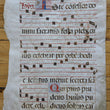

15th Century Gregorian Chant and Sheet Music - Hymn dedicated to the saints
By: Unknown
Date: 15th Century
Dimensions: 28 x 19 inches (70 x 48.25 cm)
A fine example of a Medieval Gregorian chant and sheet music on vellum with illuminated initials, likely dating from sometime within the 15th century.
Written in Latin and adorned with illuminated initials, the sheet likely belonged to a gradual or antiphonary, which are books containing the choral chants for use during the Mass or Divine Office in the Catholic Church. The manuscript is notable for its elegant Gothic script and square notation used for Gregorian chant, a common practice in church music of the time. Such manuscripts were typically produced in monastic scriptoria or commissioned by churches for choir use.
The text on this sheet includes the phrase "Confitebor tibi Domine," which translates to "I will praise you, Lord." This is a common phrase found in the Psalms and other liturgical prayers that focus on praise and thanksgiving to God. The accompanying musical notation, known as neumes, provides the choir with a guide to chant the text in unison. On the reverse side, another important phrase, "Sanctis tuis," meaning "to your saints," suggests that the text could be part of a hymn or antiphon dedicated to the saints. Such chants were integral to the celebration of feast days of saints, when prayers would be offered in their honor. The final word, "Amen," typically concludes the prayer or hymn
The Gothic script, with its elaborate and formal style, points to the manuscript's origins in the late medieval period. This type of script was widely used in Western Europe between the 13th and 15th centuries. Similarly, the square musical notation on a four-line staff is characteristic of Gregorian chant, which was the dominant form of sacred music in the medieval church. This method of notation, though simple by modern standards, allowed for the precise transmission of the melodies that accompanied liturgical texts.
Condition: This piece of Gregorian sheet music and chant is in fine condition with one small tear at lower center-right (on text side), some faint pencil markings, soiling and uneven margins that are ample enough for framing. Text and illuminated letters are bold and beautiful.
Inventory #92232
1200 W. 35th Street #425 Chicago, IL 60609 | P: (312) 496 - 3622



